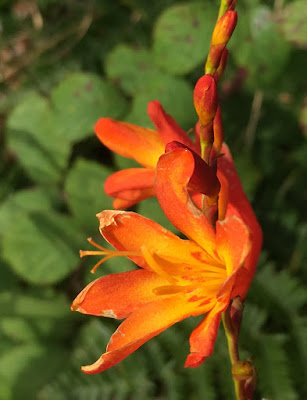Step one: cross over the peninsula on N86. This means, along the edge of beautiful super-green valley with hills rising up 1,200 feet above us. We'd already been this way the previous day and we didn't stop for pictures today, so here's one from then:

We arrived at Inch Beach - wide as can be, with a view of the hills of the Kerry Peninsula just across the water. Naturally, a beach walk ensued.

And Kevin put his feet in, as he does.

From there, we headed to the town of Dingle. We'd already been, the previous day - so we just shot through and out the other side towards the Gallarus Oratory. We didn't believe it when Google Maps told us we'd arrived til we were almost past it, and saw a small parking area with a path through the fuschia.

Yes, that's fuschia. I'd previously only encountered it as a hanging basket plant on our front porch growing up, but in Ireland, it is gargantuan and ever-present, much to my delight. So we headed down the path, and found this:
Built using the traditional drystone method - no mortar - in the 7th or 8th century.
Tight as tight can be - no rainwater can get in. One little window in the back, which faces east.
A commemorative stone. There wasn't much in the way of interpretive materials - perhaps this is a burial site.

A view from the wall encircling the site...
The "Reask Stone". Two views - note how the carving wraps around the shape of the stone itself - especially apparent at the top:
From here, we zigzagged another few miles away to Kilmakedar Church, built in the mid-12th century and displaying, architecturally, how the Irish church was trying to align itself with Rome and the rest of Europe at the time.
That's a sundial, in the foreground - a detail I missed at the time, unfortunately.
There is also an Ogham stone. Ogham is an early medieval alphabet - I'm just now reading up on it via Wikipedia and it's fascinating. This stone says "ANM MAILE-INBIR MACI BROCANN", which is a name - "Mael Inbir son of Brocán".
View from inside the church looking to the back of it. Note the arch details - that's one of the bits inspired by Rome.
After all this, we headed back to the town of Dingle to be able to head out in a different direction, on the drool-inducing Slea Head Drive that runs along the sea.
We stopped off to see some more beehive drystone huts - some of which had no roofing left, so here's me for size:
View from this site back east, toward the town of Dingle (not visible).
And now we come to the view of the Blasket Islands.
Here's the picture I was taking:
We smooch whenever possible, to the delight or annoyance of all who know us, and this seemed like a fine opportunity to indulge.
We continued toward the next headland - Coumeenoole on the map. I got a glimpse of a beehive hut and snapped this from the car window - it's that round thing topped with grass in the center of the photo.
Just around a couple of corners from here, we found a place to park along the side of the road to check out these amazing cliffs + a swimming beach. Here's the view of the beach. The pull-out where we took the previous pix of the Blaskets is visible as a little notch in the headland to the far right, below.
Looking the other way, at the cliffs. For context and scale, you may notice a couple of tiny dots on the turf at the top - those are people.
By now, our minds were officially blown. We found our way back to Dingle via a different, inland route, and took the Connor Pass back to our Airbnb. The pictures below are from the previous day when we did this same drive.
Connor Pass should be done in this direction only, we decided.
Here, watch this - enjoy the drive!
And that wasn't even the whole day. It's just the parts that got photographed.





























